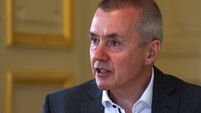Oliver Mangan: Federal Reserve shifts the focus onto US jobs and away from inflation

Federal Reserve chairman Jerome Powell is driving the biggest policy shift since the early 1980s
The euro briefly tested the key strong resistance point of $1.20 last week as the dollar came under further pressure following the US Federal Reserve’s move to a more accommodative monetary policy framework.
The fact that this support level held for the dollar is testimony to its strength and durability.
The euro has risen above the $1.20 level only once since the ECB moved to negative interest rates in 2014.
The failure of the euro to breach the €1.20 level is not to minimise the significance of the change to Fed policy. It is, arguably, the biggest policy shift since the early 1980s when the Fed, under Paul Volcker, took aim to squeeze inflationary pressures out of the US economy, raising rates to 20% in the process.
This time, the problem is a lack of inflation. The past decade has seen the US unemployment rate drop to a 50-year low of 3.5%, but inflation remained stubbornly below the Fed’s 2% target.
The Fed believes low inflation will be a feature of the next cycle also and so it can put more of a focus on helping the labour market.
It has a dual mandate of maintaining stable prices while maximising employment. It will now give greater weight to achieving its employment goal under its new policy framework.
It is now targeting an average inflation rate of 2% over time rather than a specific 2% target point.
This policy shift suggests that the US will be able to move back to full employment without the need to raise interest rates to prevent signs of overheating emerging in the economy.
It implies that interest rates are going to be maintained at their current very low levels for a longer period of time.
Normally, greater tolerance of inflation would unnerve bond markets and see curves steepen as long-term interest rates rise.
There was a brief rise in yields in response to the Fed policy shift, but it did not last and the spike quickly reversed.
This suggests markets believe that even the new looser Fed monetary stance will not be sufficient to drive inflation back above 2%.
There is simply too much slack in the economy and, in any event, inflation has been dormant for more than a decade now.
The real test for the new Fed policy regime, then, is years away and not a concern for bond markets at the present time.
However, we don’t think they would be quite as sanguine if inflation moved above 2% at some time in the future when the economy was performing strongly and moving towards full employment and rates were still near zero.










